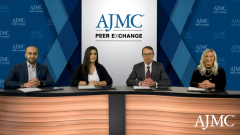
Examining Cytokine Release Syndrome
Cytokine release syndrome can limit aggressive RRMM treatment strategies.
Episodes in this series

Jeffrey Matous, MD: We’re going to talk about hurdles giving these treatments. First, let’s talk about the timing of CRS [cytokine release syndrome] to make sure everyone is clear. When we give teclistamab, we start at a baby dose and quintuple it the next 2 times to get to our full dose over the first week or so. You mentioned that we hardly ever see CRS after the step-up. Is that correct?
Kirollos Hanna, PharmD, BCPS, BCOP, FACCC: Correct. Once we get into that outpatient maintenance community side of things, or just outpatient, the median onset is on that day too. They may have fevers and some of those symptoms. In general, that’s not going to be on that day, at least when you look at the median from the MajesTEC-1 trial. The actual incidence was about 3%. Zahra said it perfectly. I’m glad we weren’t the only ones who decided not to stock tocilizumab. I was worried about that. It was a call that I made for our institution [Mayo Clinic]. But if they’re getting into grade 2 or 3, we’re going to start telling them to head to…
Jeffrey Matous, MD: There was 1 grade 3 CRS in MajesTEC-1, and the patient had concomitant…
Beth Faiman, PhD, MSN, APN-BC: ICANS [immune effector cell-associated neurotoxicity syndrome].
Jeffrey Matous, MD: And infection.
Beth Faiman, PhD, MSN, APN-BC: For our audience, the grade is based on the temperature elevation and whether they have hypotension requiring pressors or oxygen therapy. In grade 1, for a couple of patients we waited until grade 2. Some patients developed ICANS. CRS can occur as a direct result of the therapy. That can occur by itself or with ICANS. We have the ICE [immune effector cell-associated encephalopathy] score, which is like a mental status.
The nurse or the provider will go in every 8 hours in the hospital and ask them to count backward from 100, 90, or 80. We have them write their names. We look for little clues of neurocognitive changes because they can be very big deal. This can land them in the intensive care unit. Fortunately, with teclistamab and the step-up dosing and close monitoring in the hospital, I haven’t seen it, but it’s happened once or twice—the second 1 might have been an infection. That’s why they have to be started as an inpatient.
Jeffrey Matous, MD: Our panel has quite a bit of experience with clinical trials using bispecifics but also teclistamab. Do we think there’s going to be a difference between the patients treated on the clinical trials, reported in MajesTEC-1, and real-world patients?
Beth Faiman, PhD, MSN, APN-BC: One hundred percent.
Zahra Mahmoudjafari, PharmD, MBA, BCOP, FHOPA: Yes.
Jeffrey Matous, MD: I’m thinking in terms of tolerability, response rate, and toxicity. Zahra?
Zahra Mahmoudjafari, PharmD, MBA, BCOP, FHOPA: Yes, 100%. The patients on a clinical trial have met inclusion and exclusion criteria. They’re ideal patients. But real-world patients are far more complex. They have comorbidities. They have other medications they’re taking. There’s a significant difference.
The other thing that comes to mind, looking at the pipeline, is that there are more bispecifics coming. We have a need for creating a cytokine release syndrome or neurotoxicity algorithm approach to teclistamab. But what if each bispecific is coming out? Each will have its own profile. Perhaps we’ll have a management approach for each type of bispecific, trispecific, or other upcoming agents. It’s not going to be 1 size fits all, as much as we want it to be and as much as that would make me happy.
We’ll find that some of these agents have a higher risk of cytokine release syndrome; therefore, we do need to do tocilizumab more up front. Or some of them have less, so the management can be done in the outpatient setting. Academic centers have done an incredible job of steering community providers to manage CRS. But we need to backtrack a little and spend some time educating.
Jeffrey Matous, MD: Also neurotoxicity…
Zahra Mahmoudjafari, PharmD, MBA, BCOP, FHOPA: Right, neurotoxicity.
Jeffrey Matous, MD: Because anti-teclistamab ICANS neurotoxicity is very rare.
Zahra Mahmoudjafari, PharmD, MBA, BCOP, FHOPA: We need to backtrack and re-educate.
Beth Faiman, PhD, MSN, APN-BC: I’d like to underscore the importance that this is a partnership. Having that patient, early on in their disease—we talked about survivorship in another area—having them established with a large hospital center in the community and vice versa, and sharing knowledge, thoughts, and the care of the patient will empower the patient to feel more comfortable about coming back. It helps the community doctor feel better about managing that patient. It’s a 2-way street. That’s where the care of myeloma is going to grow and expand. It has to start at the beginning and continue throughout the disease trajectory. For critical periods when they’re flying up and have the aggressive relapse biochemical, they have to come down to the larger hospital in Kansas. Then they can go back to the community.
Transcript edited for clarity.
Newsletter
Stay ahead of policy, cost, and value—subscribe to AJMC for expert insights at the intersection of clinical care and health economics.





























































